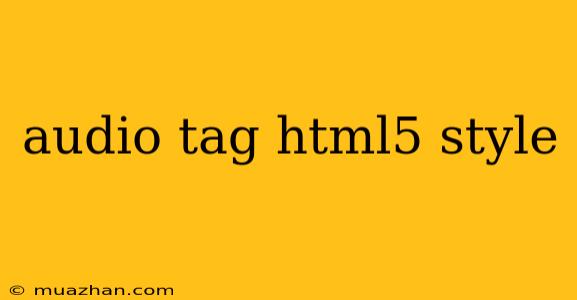Styling the HTML5 Audio Tag: A Comprehensive Guide
The HTML5 <audio> tag provides a powerful and flexible way to embed audio content directly into web pages. While it offers basic functionality out of the box, you can elevate your audio experiences by incorporating CSS styling techniques. This guide will explore various ways to customize the appearance and behavior of your HTML5 audio players.
Understanding the <audio> tag
Before diving into styling, let's understand the basic structure of the <audio> tag:
This code creates a simple audio player with:
controlsattribute: Enables default playback controls (play, pause, volume, etc.).sourceelement: Specifies the audio file's location and MIME type.- Fallback message: Displays if the browser doesn't support the audio element.
Styling the Default Controls
While the default controls are functional, they might not align with your website's design. You can customize their appearance using CSS:
audio::-webkit-media-controls-panel {
background-color: #f0f0f0;
border: 1px solid #ccc;
}
audio::-webkit-media-controls-play-button,
audio::-webkit-media-controls-pause-button {
background-color: #333;
color: #fff;
}
audio::-webkit-media-controls-current-time-display,
audio::-webkit-media-controls-time-remaining-display {
font-size: 14px;
font-weight: bold;
}
This example changes the background, border, button colors, and font styles of the default controls.
Important Considerations:
- Browser Compatibility: CSS styles for audio controls may vary across browsers. Use vendor prefixes (e.g.,
-webkit-,-moz-) to ensure compatibility. - Customization Limitations: Styling the default controls has limitations. For extensive customization, consider using custom audio players.
Building Custom Audio Players
For complete control over the audio player's design, you can build your own using HTML, CSS, and JavaScript:
1. Structure:
0:00 / 0:00
2. Styles:
.audio-player {
width: 300px;
background-color: #eee;
border-radius: 5px;
padding: 10px;
}
.controls {
display: flex;
justify-content: space-between;
align-items: center;
}
.play-pause {
/* Add styles for play/pause button */
}
/* ... other styles for progress, time display, etc. */
3. JavaScript:
const audio = document.getElementById('audio-element');
const playPauseButton = document.querySelector('.play-pause');
playPauseButton.addEventListener('click', () => {
if (audio.paused) {
audio.play();
// Update play/pause button icon
} else {
audio.pause();
// Update play/pause button icon
}
});
// ... Add event listeners for progress, time updates, etc.
This code provides a basic outline for a custom audio player. You can further customize the player by adding features like volume control, track selection, and visual feedback for playback status.
Libraries and Frameworks
For more advanced functionality and ease of use, consider using audio player libraries and frameworks:
- Howler.js: A powerful JavaScript library for audio management and playback.
- Mejs (MediaElement.js): A versatile framework for enhancing HTML5 media elements.
- Plyr: A modern, accessible, and lightweight audio/video player library.
These libraries and frameworks offer pre-built components, styling options, and APIs for seamless audio integration.
Conclusion
Styling the HTML5 audio tag allows you to create engaging and visually appealing audio experiences. You can choose between customizing the default controls with CSS or building custom players with HTML, CSS, and JavaScript. Libraries and frameworks can provide additional features and simplify the development process. By combining these approaches, you can effectively enhance the audio experience on your web pages.
